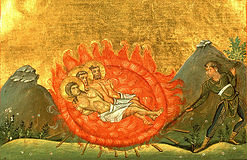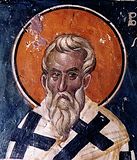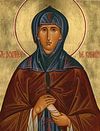

| Previous day | Next day |
| Old Style
February 6
|
Friday |
New Style
February 19
|
|
37th Week after Pentecost.
Tone 3.
Fast Day. |
Fish, wine and oil allowed.
|
![]() St. Bucolus, bishop of Smyrna (ca. 100).
St. Bucolus, bishop of Smyrna (ca. 100).
Virgin-martyr Dorothea, and with her Martyrs Christina and Callista, sisters, and Theophilus, at Caesarea in Cappadocia (288-300). Virgin-martyr Fausta, and with her Martyrs Evilasius and Maximus, at Cyzicus (305-311). Martyr Julian of Emesa (312). Sts. Barsanuphius the Great and John the Prophet, monks of Gaza (6th c.). St. Photius, patriarch of Constantinople (891). Virgin-martyrs Martha and Mary and their brother Lycarion at Tanis (Hermopolis) in Egypt. St. Dorothea, schemanun, of Kashin (1629).
New Hieromartyr Dimitry Rozhdestvensky, archpriest, of Verny, and his son New Martyr Anatole (1922). New Hieromartyr Basil Nadezhnin, priest, of Moscow (1930).
St. James, ascetic, of Syria (ca. 460). St. Mael, bishop of Ardagh (488), disciple of St. Patrick. St. Vedast, bishop of Arras (540). St. John of Thebes, monk of Palestine (6th c.) St. Amand, apostle of Maastricht (675). St. Arsenius of Iqalto, Georgia (1127).
Repose of Archbishop Theophan (Bystrov) of Poltava (1940).
Thoughts for Each Day of the Year
According to the Daily Church Readings from the Word of God
By St. Theophan the Recluse

Friday. [II Pet. 1:1–10; Mark 13:1–8]
Having enumerated the virtues which we must seek with all diligence, having received grace-filled power, the Apostle says by way of encouragement, If these things be in you, and abound, they make you that ye shall neither be barren nor unfruitful in the knowledge of our Lord Jesus Christ (II Pet. 1:8). The virtues to which he refers here were mentioned in I Pet. 2:21–3:9. Now we shall add only that we are required to manifest these virtues not just once, but rather to make them always abide in us, to be part of our essence, to take root in us. Thus, they must not remain on one level, but ever multiply and grow in strength and fruitfulness. Only then, he says, will you not be barren and unfruitful in the knowledge of our Lord Jesus Christ (II Pet. 1:8). He who believes in Him and confesses Him enters into the knowledge of the Lord. “You believe?” says the Apostle! See then, that your faith be not barren and unfruitful. What should I do, so that my faith will not be that way? Prosper in every virtue. Where are those who repeat over and over that believing is enough: that nothing more is needed?! Whoever thinks this way is blind.
Articles
 St. Bucolus the Bishop of SmyrnaSaint Bucolus, Bishop of Smyrna, was a disciple of the holy Apostle and Evangelist John the Theologian, and became the first Bishop of Smyrna (Asia Minor). |
 Virginmarty Fausta at CyzicusThe girl bravely confessed her faith and was subjected to many cruel tortures. |
 Martyr Evilasius at CyzicusSaint Evilasius was an eighty-year-old pagan priest who was ordered to turn Saint Fausta away from Christ. |
 Martyr Maximus at CyzicusThe eparch Maximus was sent to investigate the case of Saints Fausta and Evilasius for the emperor, and he began to torture the old man who had come to believe in Christ. |
 Martyr Julian of EmesaHe was a skilled physician, and healed illnesses not only of the body but also of the soul, and he converted many people to faith in Christ the Savior. |
 Venerable John the ProphetSaint John, a disciple of Saint Barsanuphius, lived in a cell outside the monastery of Abba Seridus for eighteen years until his death. |
 St. Arsenius of Iqalto in GeorgiaSaint Arsen of Iqalto was a translator, researcher, compiler of manuscripts, hymnographer, philosopher, and a great defender of the Georgian Christian Faith. |









